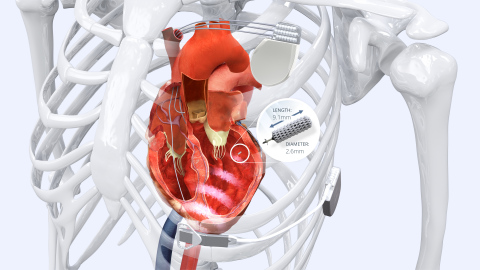SUNNYVALE, Calif.--(BUSINESS WIRE)--EBR Systems, Inc., developer of the world’s first and only wireless cardiac pacing system for heart failure, has raised $50 million to conduct the global SOLVE-CRT study. The financing was led by Australian private equity firms M.H. Carnegie & Co. and Brandon Capital Partners and included participation by prior investors Split Rock Partners, Ascension Ventures and Dr. Thomas Fogarty’s Emergent Medical Partners. EBR Systems’ WiSE™ (Wireless Stimulation Endocardially) Technology paces the heart via a wireless electrode implanted directly in the left ventricle with an initial indication sought for heart failure patients who have failed to respond to or are unable to receive conventional cardiac resynchronization therapy. The SOLVE-CRT (Stimulation Of the Left Ventricle Endocardially) study is a pivotal clinical trial intended to establish safety and efficacy in support of U.S. Food and Drug Administration approval. “We are pleased to have the support of such a solid syndicate of investors and look forward to definitively proving the clinical effectiveness of wireless pacing in SOLVE-CRT,” said Allan Will, Chairman and CEO of EBR Systems.
Separately, the Company has received European CE Mark approval for its second-generation wireless transmitter and conducted initial cases at four European clinical centers. This major advance is half the size of the first-generation transmitter, extends battery life and enables a simpler and less-invasive implantation procedure. “The WiSE CRT system has enabled me to successfully treat many patients who had previously failed treatment with conventional CRT devices,” said Dr. Tim Betts of Oxford University Hospitals NHS Foundation Trust, John Radcliffe Hospital. “Without WiSE, these heart failure patients would be relegated to progressive deterioration of their condition and repeated hospitalizations. The second-generation system has allowed me to transform a two-day or two-admission procedure into a single procedure treatment, minimizing hospital stay and allowing the patient to experience the benefits of CRT immediately.”
Cardiac Resynchronization Therapy for Heart Failure
Studies have demonstrated that successful CRT therapy reduces heart failure symptoms, hospitalizations and mortality by synchronizing the left and right ventricles. More than one-third of annual pacemaker sales are for this indication. However, approximately 30 percent of patients receiving conventional CRT do not respond to the therapy. A major cause of this shortcoming is believed to be the inconsistency of results achieved using wire leads to pace the left ventricle from within the coronary sinus vein on the epicardial (exterior) surface of the heart. Although it is generally accepted that stimulation of the left ventricle is preferable from inside the heart, wire leads or large implants placed inside the left ventricle can cause clots, heart attacks or strokes. Consequently, commercially-available CRT systems do not place leads there, using the coronary sinus instead. Additionally, wire leads can break or otherwise fail, leading to complications in roughly 12 percent of cases. The financial impact of these issues is profound. As much as $1 billion of $3.5 billion spent annually on CRT devices provides no patient benefit.
EBR Systems’ WiSE Technology is the world’s only wireless, endocardial (inside the heart) pacing system in clinical use for stimulating the heart’s left ventricle. This has long been a goal of cardiac pacing companies since internal stimulation of the left ventricle is recognized as a potentially superior, more anatomically correct pacing location. WiSE Technology addresses those problems by enabling cardiac pacing with a novel cardiac implant that is roughly the size of a large grain of rice. The need for a pacing wire on the outside of the heart’s left ventricle – and the attendant problems – are potentially eliminated.
Chris Nave, managing director of Brandon Capital Partners, said, “We are pleased to lead this financing that will enable what we believe will be a landmark study in cardiac rhythm management. The SOLVE-CRT study provides hope for countless heart failure patients who have no promising therapeutic alternatives.”
Trevor Moody, partner at M.H. Carnegie & Co. added, “As a former pacemaker engineer and seasoned industry investor, I am excited to back EBR Systems and its WiSE CRT System for wireless endocardial stimulation. I am convinced that wireless pacing represents the future of cardiac pacing and that EBR Systems is at the forefront of this critical technology.”
About EBR Systems
EBR Systems is dedicated to superior treatment of cardiac rhythm disease by providing more physiologically effective stimulation through Wireless Stimulation Endocardially (WiSE). The company’s patented, proprietary technology was developed to eliminate the need for cardiac pacing leads, historically the major source of complications and reliability issues in cardiac rhythm disease management. The Company’s initial product eliminates the need for coronary sinus leads to stimulate the left ventricle in heart failure patients requiring CRT. Future products will address wireless endocardial stimulation for bradycardia, and other non-cardiac indications.
The Company’s wireless pacing system is not currently available for commercial sale in the United States.
About Brandon Capital Partners
Brandon Capital Partners is a specialist life science venture firm that manages the Medical Research Commercialization Fund (MRCF), Australia and New Zealand’s largest life science investment fund, with AU$530M under management. The MRCF is a unique collaboration between major Australian superannuation funds, the Australian and New Zealand governments, Australian state governments and more than 50 leading medical research institutes and research hospitals. http://www.brandoncapital.com.au/
About M.H. Carnegie & Company
M.H. Carnegie & Co. is a leading Australian private equity and alternative asset manager with over AU$500M under management. Carnegie’s investment focus is on high value medical device technologies, with particular emphasis on opportunities that leverage the best innovations, development pathways, management teams and financing strategies. http://mhcarnegie.com/

